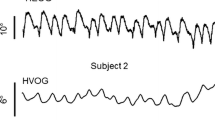Abstract
We compared the visual evoked EEG potentials (VEP) elicited by presentation of a reversal chess pattern in patients with glaucoma and in the control group. Amplitudes, peak latencies of the main VEP components (N75, P100, and N145), interpeak intervals, and interpeak magnitudes were measured, and a spectral analysis of the averaged VEP was performed. In patients suffering from glaucoma, the latencies of the N75 and P100 components were greater, while the interpeak intervals P100-N145 and N75-N145 were shorter, than those in the control group. Glaucoma-related changes in the VEP spectral characteristics, in particular a drop in the spectral power of oscillations corresponding to the alpha rhythm, were observed.
Similar content being viewed by others
REFERENCES
A. M. Shamshinova and V. V. Volkov, Functional Methods in Ophthalmologic Examinations[in Russian], Meditsina, Moscow (1998).
L. C. Bray, K. W. Mitchell, J. W. Howe, and A. Gashau, “Visual function in glaucoma: a comparative evaluation of computerized static perimetry and the pattern of visual evoked potentials,” Clin. Vis. Sci., 7, 21-29 (1992).
V. N. Marinchev, “Visual field and the visual nerve in glaucoma,” Vestn. Oftalmol., No. 4, 79-82 (1978).
V. Parisia, “Impaired visual function in glaucoma,” Clin. Neurophysiol., 112, 351-358 (2001).
G. Jenkins and D. Watts, Spectral Analysis and Its Applications[Russian translation], Issue 2, Mir, Moscow (1972).
G. Box and G. Jenkins, Time Series Analysis: Forecasting and ControlHolden-Day, San Francisco (1976).
V. P. Borovikov and I. P. Borovikov, STATISTICA, Statistical Analysis and Data Processing within the Windows Medium[in Russian], Filin Inf.-Publ. House, Moscow (1997).
V. P. Borovikov, A Popular Introduction to the STATISTICA Program[in Russian], Computer Press, Moscow (1998).
G. N. Kryzhanovskii, E. M. Lipovetskaya, and O. P. Kopp, “A study of the role of the sympathetic nervous system in pathogenesis of experimental glaucoma,” Byull. Éksp. Biol. Med., 89,No. 5, 535-538 (1980).
G. Ya. Chernyavskii, Role of the Hypothalamus in Pathogenesis of Primary Glaucoma[in Russian], Abstr. of Doctoral Thesis, Med. Sci., Kyiv (1971).
V. V. Gnezditskii, Evoked Brain Potentials in Clinical Practice[in Russian], Publishing House of the TRTU, Taganrog (1977).
M. V. Aleksandrov, G. A. Sofronov, V. I. Shostak, et al., “Involvement of cholinergic mechanisms in the functioning of specific structures of the visual analyzer,” Fiziol. Cheloveka, 22,No. 2, 64-68 (1996).
Yu. A. Aref'eva, “Contrast and color sensitivity in the diagnostics of glaucoma: neurophysiological aspects,” Vestn. Oftalmol., No. 4, 49-51 (1998).
V. C. Greenstein, S. Seliger, V. Zemon, and R. Ritch, “Visual evoked potential assessment of the effects of glaucoma on visual subsystems,” Vis. Res., 38, 1901-1911 (1998).
V. G. Kolesnikov, Electronics. An Encyclopedic Vocabulary[in Russian], Sovetskaya Entsiklopedia, Moscow (1991).
K. A. Saltykov and I. A. Shevelev, “A simulation study of the mechanisms of tuning of visual cortex neurons to incomplete cross-like figures,” Zh. Vyssh. Nerv. Deyat., 51,No. 2, 174-181 (2001).
N. A. Lazareva, I. A. Shevelev, R. V. Novikova, et al., “A disinhibitory zone of the receptive field of a striate neuron and its sensitivity to a cross-like figure,” Sechenov Ross. Fiziol. Zh., 87,No. 4, 514-522 (2001).
A. K. Kharauzov, Yu. E. Shelepin, S. V. Pronin, et al., “Visual evoked potentials at dichoptic presentation of test sinusoidal lattices and a hindrance,” Sechenov Ross. Fiziol. Zh., 87,No. 2, 261-269 (2001).
G. A. Kuraev and V. V. Babenko, “Dependence of the threshold shift of the sinusoidal lattice on its spatio-temporal characteristics,” Fiziol. Cheloveka, 26,No. 4, 30-37 (2000).
V. D. Glezer, “On the role of spatio-frequency analysis, primitives, and interhemisphere asymmetry on identification of visual images,” Fiziol. Cheloveka, 26,No. 5, 145-150 (2000).
E. Basar, “Event-related oscillations are ‘real brain responses’ — wavelet analysis and new strategies,” Int. J. Psychophysiol., 39, 91-127 (2001).
V. N. Kiroi and E. I. Belova, “Mechanisms of formation of oscillatory activity of neuronal populations and its role in systemic brain activity,” Zh. Vyssh. Nerv. Deyat., 50, Issue 2, 179-191 (2000).
I. A. Shevelev, E. D. Bark, and V. M. Verkhlyutov, “Alpha scanning of the visual cortex: data of EEG and magneto-resonance tomography,” Sechenov Ross. Fiziol. Zh., 87,No. 8, 1050-1057 (2001).
Author information
Authors and Affiliations
Rights and permissions
About this article
Cite this article
Snegir', M.A. Modifications of Visual Evoked Potentials in Patients with Glaucoma. Neurophysiology 34, 52–57 (2002). https://doi.org/10.1023/A:1020270025606
Issue Date:
DOI: https://doi.org/10.1023/A:1020270025606




